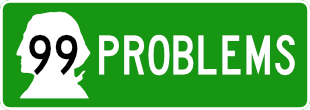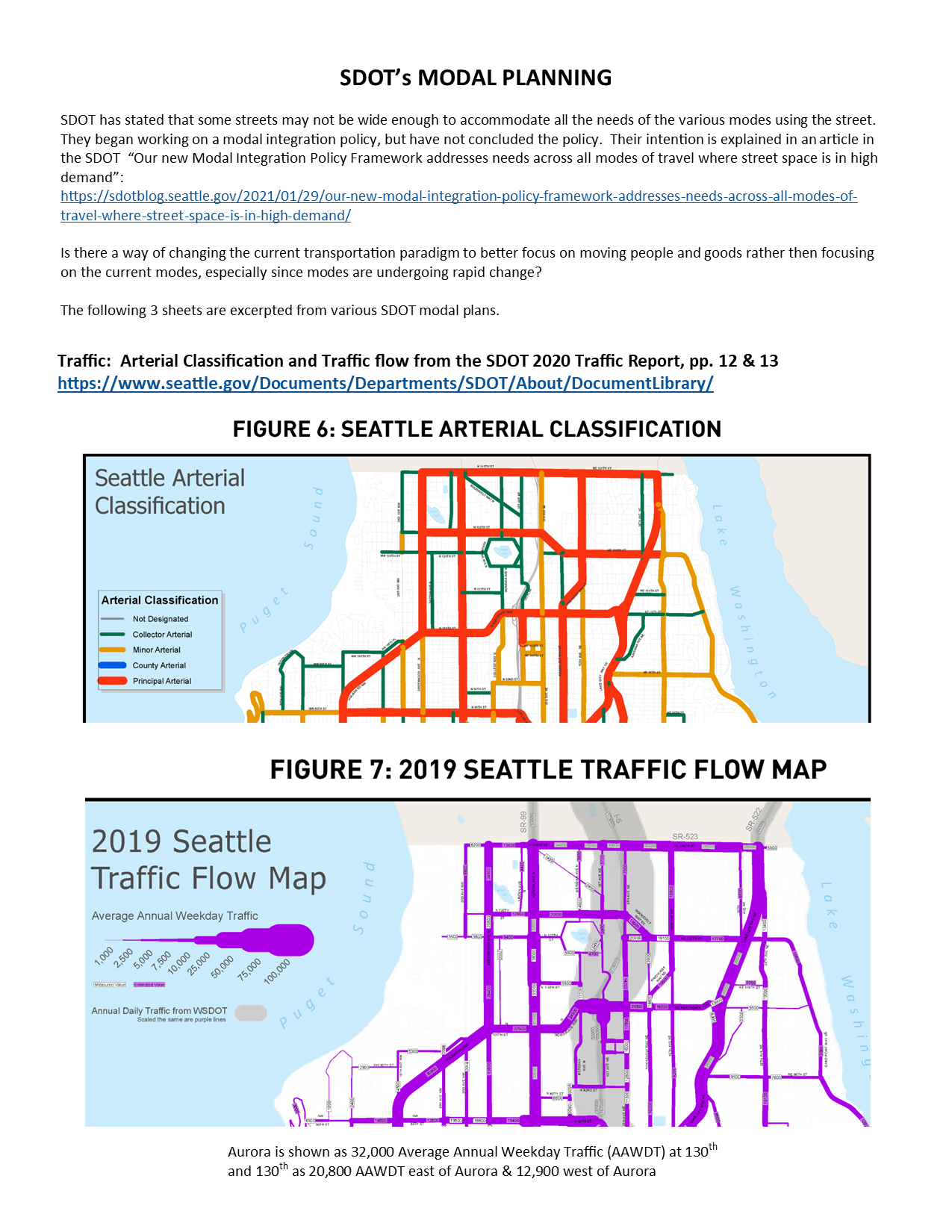The Aurora Reimagined Coalition is committed to a long-term vision for Aurora, as well as accomplishing short-term wins. When looking at the intersection of Aurora Ave N and N 130th Street, we have identified a number of improvements that should be implemented prior to the 130th Street light rail station opening in 2024, if not immediately.
For more background and detail on this area, watch this presentation at the Haller Lake Community Club’s virtual monthly meeting, held on November 4, 2021.
Proposed Improvements to N 130th Street
The goals that are most important at the intersection of 130th and Aurora are (1) safe passage for all users, but especially pedestrians, bicyclists, and disabled people and (2) relieving some of the effects of the urban heat island effect by adding green space and/or trees.
1. Leading pedestrian intervals
Most pedestrians cross the intersection at 130th and Aurora at grade. It has an above-grade pedestrian bridge on the north side, but the stairs are steep and unusable by people who are infirm, in wheelchairs, or accompanied by strollers, grocery carts, or other rolling implements.
Many of the pedestrians are elderly or infirm from the 251 unit seniors’ housing complex a block away.
Hundreds of students attending school at Ingraham High School flood across Aurora at bell time. Our proposal is consistent with the Safe Routes to School program to safeguard the students’ movement to school.
The traffic signals here have multiple phases to permit left turns in all directions. As it stands now, we believe that the signal timing prioritizes use by cars and does not prioritize the safety of people outside of cars. One way to improve this is to reprogram the signals during all of its sequences so that there is a short head start for pedestrians, including children and wheelchair users, before the cars begin to cross. This improvement would likely involve very minimal cost, only the time necessary for an engineer to reprogram the signals.
2. Restricted right turns on red in all four directions
The large number of right turns from all directions compounds the dangers pedestrians face described above. Another way to improve pedestrian safety is to restrict car traffic through the crosswalks during red lights by posting No Right on Red signs. Again, this proposal involves minimal cost to install the signs but could provide significant safety improvements in the use of the crosswalks.
In addition to pedestrians, adding No Right on Red signs would also increase bicyclist safety in the area by reducing the traffic that crosses over a cyclist’s path during a red light.
3. Adding sidewalks and curbs where missing on the west side of Aurora from 130th to 135th
Currently the west side of Aurora between 130th and 145th has only a few short sporadic sidewalks. Ironically, most pedestrians’ convenient routes along this section of Aurora take them down the shoulder on its west side instead of the sidewalk on its east side. It is heavily travelled by pedestrians including the elderly and those in wheelchairs.
Adding sidewalks and curbs along this stretch of road would improve pedestrian safety and would increase walking traffic to local businesses (banks, restaurants, and coffee shops).
Directly in front of the under-construction new Amazon delivery hub there is a ditch instead of a sidewalk. There will be a great increase in traffic at this location with Amazon delivery drivers hurrying to meet their quotas.
Seattle requires most new construction and significant remodels involving a change of use to include public sidewalks. Amazon significantly reconstructed an existing building and changed its use from retail to a delivery hub. Why were they not required to install sidewalks, curbs, proper drainage, and a safer vehicle entrance/exit? At the least, the City should attempt to partner with Amazon to provide public safety at their new facility.
The crosswalk on the northwest corner of the intersection at 130th ends with a guard rail, a parking stall, and several awkwardly placed curbs that form a tripping hazard. If a full sidewalk along this portion of Aurora must be delayed, as an urgent interim solution the pedestrian conditions at the intersection should be improved.
Similarly, there is a dangerous condition at the north end of the block at N. 135th St. A Rapid-Ride bus stop is about 100 feet from the intersection, but to get to it one must walk across an unimproved driveway while dodging cars whose drivers are trying to negotiate a confusing mix of turning traffic at the intersection. This bus stop serves many elderly accessing the Social Security Regional office near the northeast corner of the intersection. If a full sidewalk along this portion of Aurora must be delayed, SDOT must focus attention on resolving this situation.
4. New bus shelters on north and south sides of 130th at Aurora
Vehicular traffic along 130th has increased in recent years and is anticipated to increase much more once the 130th Street light rail station opens. Additionally, this will be a major transfer point between the buses serving the 130th St. station and Aurora’s E-Line; pedestrian traffic across the intersection will also increase.
The bus shelter on the north side of Aurora is very constrained, especially at bell times when hundreds of students at Ingraham High School are flooding the area. There may be enough room under the trees and the overpass to expand the bus waiting area into a small mini-plaza.
The bus shelter on the south side of Aurora is similarly constrained. The situation is made worse by the lack of proper sidewalks and curbs. It, too, should be improved. Fortunately, the City of Seattle owns the adjacent property, currently short-term leased to an auto distributor. SDOT and Seattle’s Facilities Department should determine how to best add improvements here.
5. Trees/green space on SE corner
The entire Aurora corridor is largely made of concrete. Concrete absorbs thermal energy and makes temperatures in the immediate vicinity rise, known as the urban heat island effect. Temperatures along Aurora are routinely higher than on neighboring more tree-lined streets.
In addition, concrete is an impervious surface, which increases run-off from storms because storm water cannot be absorbed into soil. Increased run-off puts more pressure on municipal stormwater and sewage facilities.
Green space and trees reduce concrete, increase water absorption into soil, reduce run-off, and lower temperatures. Green space and trees also provide a more comfortable and pleasant space, making the road and the area more hospitable to city residents.
Street trees also add to roadway safety. Grown trees add an additional safety barrier separating traffic and trees calm traffic making the roadway appear narrower and less like an expansive highway.
The property on the SE corner of the intersection at 130th is owned by the City of Seattle. SDOT and the city’s Facility Department should determine the best way to add street trees to this location.
6. Protected bike route from Interurban Trail to Ashworth to connect with path to light rail
Currently, cyclists have few good options to travel between northwest Seattle and the 130th Street light rail station. And there is no safe way for a cyclist to travel east-west across I-5 for over 2.5 miles between the new bridge at Northgate and N. 155th Street in Shoreline.
An “all ages and abilities” way for bicycles to get from the interurban Trail at Linden Ave N to the station at 130th is needed.
Over the last few years the OPCD and SDOT have studied the issue extensively and produced a webpage for the NE 130th 145th Multimodal Access Plan by OPCD, July 2020 and an extensive report: NE 130th St & Shoreline South/148th Stations: Multi Modal Access Study – Final Report by SDOT, Dec. 2020.
Summary extracts, including maps, are on pp. 11 – 13 in our attached North Aurora Background – Aurora Near 130th St.
In those reports, the problems, opportunities, and constraints were identified but no solution was proposed. No easy problem-free route was identified and recommended. But it’s an important decision that needs to be made shortly, in time for implementation for the opening of the 130th Street and 145th Street stations. More study won’t make the problems go away. It’s incumbent on SDOT and OPCD to finish their evaluation and make a recommendation for decision by the Mayor and Council.
In the above-referenced studies 130th was shown as likely having a protected bike lane. It has long been presumed that it would have one since the first bicycle master plan was approved in 2014. There are existing unprotected bike lanes along 130th from Aurora west to Linden. The studies show a bike route along 130th Street from the 130th Street light rail station variously to 1st Street NE, or to Ashworth Ave., or the entire length to Greenwood Ave. There is enough right of way for protected lanes to be added in at least most of that length. The city owns all property on the south side of 130th from halfway between Ashworth and Stone to Aurora. If limited widening of 130th were required over that portion it may be feasible.
Potential alternative routes were identified in the above SDOT and OPCD studies using 138th Street, or using 137th Street to Roosevelt Way, or Corliss, or 1st Ave. NE.
In any case, a final analysis and recommendation by SDOT and OPCD and decision by the Mayor and Council is needed shortly to allow for implementation prior to the 130th Street station opening.

















